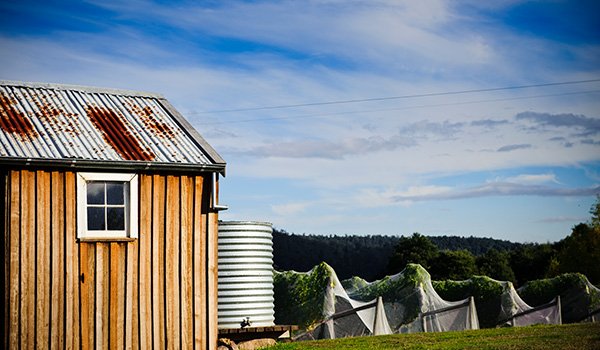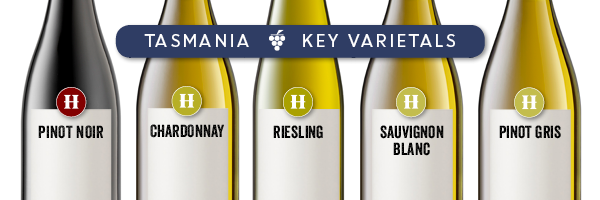Tasmania
About Tolpuddle Vineyard
Australia’s coldest wine area is renowned for its exceptional sparkling, pinot noir, and chardonnay. In addition to that wealth, Tasmania boasts some of the purest air on Earth, stunning natural landscapes, and fresh produce to complement its refined, crisp wines.
Become a member of Halliday Wine Club now and savor some of Australia’s finest wines, featuring selections from the famous Tasmanian area and other highly rated wine regions throughout the nation.

Welcome to Tasmania
Our island state has quickly established itself as a renowned Australian wine destination, with numerous winemakers relocating from the mainland to acquire prized vineyards or to now obtain its renowned pristine fruit. From the Tamar Valley’s verdant, twisting scenery to the picture-postcard-worthy East Coast, excellence prevails.
Tasmania’s sparkling wines are internationally famous, and its pinot noir, chardonnay, and riesling are esteemed by eateries and vendors. The sole drawback is that these wines have limited availability, and not all of them reach the other side of the strait. This final point is a significant one. The popularity of Tasmania’s wines results in a price that is above average, ranking it among our most high-end regions.
Along with art, cuisine, and nature that attract visitors, Tasmania offers an inspiring setting for some of Australia’s most thrilling wines.
The history of wine in tasmania
Tasmania possesses an unexpectedly lengthy history of winemaking. Indeed, as stated in James Halliday’s Wine Atlas of Australia, the initial vines in Victoria and South Australia originated from this location, specifically from Port Arthur in the south. Bartholomew Broughton established Tasmania’s initial commercial vineyard in 1823, and by 1865, there were 45 different varieties cultivated. Shortly thereafter, winemaking activities virtually stopped, “at least partly because of the gold rush on the mainland,” and it didn’t resume for almost a century.
Tasmania’s contemporary winemaking history started in the mid-1950s, when the Hydro-Electric Commission supported two of its trailblazers – Jean Miguet, who established the first vineyards in the north, and Claudio Alcorso, who two years later opened Moorilla in the south.
Currently, there is a blend of producers based in Tasmania, including family-owned vineyards, innovative new wave creators, and large corporate enterprises. In Australia, Tasmania has emerged as the winemaking hub of the 21st century, with individuals competing for a share of the opportunity. Nevertheless, the rivalry for this revered area has restricted all but a select few from relocating, preserving Tasmania’s status as a top-tier destination.
The wine regions of tasmania
Northern Tasmania
Northern Tasmania represents over half of the state’s production, and as per James, features “terroir and climate as varied as southern Victoria, maturing every varietal from chardonnay and pinot noir to shiraz and cabernet sauvignon.”
Tamar Valley
This subregion accounts for the majority of Tasmania’s wine output, featuring a milder climate compared to other parts of the state. Although it continues to create Tassie classics like sparkling and pinot noir, the mix of warmer temperatures and clay-limestone soils allows for reds that are richly colored and flavored
Pipers River
Close to the Tamar Valley lies the Pipers River subregion, an area characterized by James as “rolling, wooded, and verdant for much of the year.” It produces roughly 50% of the wine that the Tamar Valley does, and its soils are distinct as well – they are red volcanic instead of gravelly. Combine that with a refreshing, Champagne-like climate, and it’s an ideal spot for sparkling wine.
Northwest Tasmania
The smallest and newest winemaking area of the north, this pretty spot near the coast is home to a handful of producers making stellar, cool-climate styles. Pinot noir, pinot gris, chardonnay and riesling are just some of the varieties made here.
Southern Tasmania
With Tasmania’s base directed at Antarctica, the south contains the chilliest winemaking region in Australia, and its total areas comprise merely about a fifth of the state’s overall wine output, generating some highly sought-after limited editions.
Derwent Valley
Coal River Valley
Right near the Hobart Airport, the Coal River Valley is interesting in that it’s much drier than other parts of the state. Add to that sandy soils, and it’s a great environment for aromatic varieties, particularly later-ripening types. As well as the classics, cabernet sauvignon does well here.
Huon Valley and the Channel
East Coast Tasmania
In terms of its wine production, the East Coast of Tasmania is similar in size to Northern Tasmania’s Pipers River. It has enticing white-sand beaches and picturesque coastal parklands alongside its cellar doors, and lovers of the outdoors will make a beeline for the Freycinet National Park and its much-photographed Wineglass Bay. The combination of the Tasman Sea and lush green country means some incredible produce, too, and you can wade in oyster farms, visit orchards, and enjoy some excellent dining.
Tasmania’s top wine styles
Approximately 75% of Tasmania’s wine output consists of pinot noir and chardonnay, along with sparkling wine produced from these types. Other impressive cool-climate varieties that excel here include sauvignon blanc and riesling, while regions like the Tamar and Coal River Valleys are gaining recognition for fuller-bodied reds, producing cabernet sauvignon, merlot, and even shiraz

Chardonnay
Tasmania is known for its lean style with excellent natural acidity. Chardonnay from the region is utilized for table wines, as well as sparkling wines deemed among the finest globally
Pinot noir
Tasmania is characterized by a scented variety of pinot noir with a subtle flavor profile. This red grape prevails in the region, accounting for almost half of the state’s wine output, and it is also utilized in its superb sparkling wines
Riesling
Although it accounts for just a tiny fraction of Tasmania’s wine output, riesling from this region is gaining popularity, showcasing a clearly different style compared to mainland varieties. Bold and clean, Tasmanian riesling is available in dry, off-dry, sweet, and even bubbly varieties.
Sauvignon blanc
Pinot gris
Tasmania is characterized by a scented variety of pinot noir with a subtle flavor profile. This red grape prevails in the region, accounting for almost half of the state’s wine output, and it is also utilized in its superb sparkling wines
Things to do in tasmania (and planning your trip)
The primary access points to Tasmania are Hobart and Launceston, with each serving as a gateway to various attractions and wine regions. For the Derwent, Huon, and Coal River Valleys in southern Tasmania, go to Hobart and get ready to enjoy wine, food, stroll along the waterfront, explore the markets, and relax in the pubs of Battery Point. For the Tamar Valley and Pipers Brook in northern Tasmania, purchase your ticket to Launceston, a getaway filled with serene scenery. Launceston will serve as your ideal starting point for East Coast adventures, allowing you to build up an appetite for fresh oysters and leisurely lunches during kayaking trips and hinterland hikes. It’s quite simple to drive across the state from either end, depending on the time available to you.
Art enthusiasts: be sure to visit MONA (the Museum of Old and New Art) located in the south.
Adventurers: the Overland Track is a popular hiking route in northern Tasmania.
Food enthusiasts: the produce route in Tasmania offers opportunities to gather exceptional olive oil, honey, and even wade for oysters.
Every citation and piece of information in this guide comes from James Halliday’s Wine Atlas of Australia
